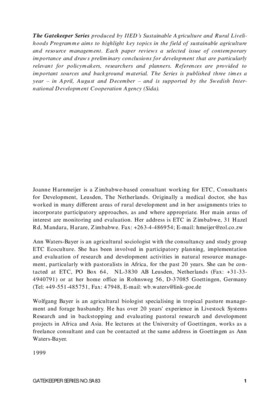Dimensions Of Participation In Evaluation: Experiences from Zimbabwe and the Sudan

Participatory evaluation (PE) of development co-operation has become increasingly popular in recent years. It can have a number of advantages over conventional evaluations, whose outcomes often depend on the evaluators' ability to see through the 'screens' thrown up by those being evaluated, and on the individuals selected for the task, and can engender little sense of ownership of findings amongst project staff. However, the literature on participatory evaluation tends solely to emphasise participation by beneficiary communities in the evaluation process. In this paper, the authors draw on two participatory evaluations conducted in Zimbabwe and the Sudan. They argue that the view that beneficiaries must be the sole focus to make an evaluation 'participatory' is untenable. Indeed, an exclusive focus on participation of the beneficiaries limits the extent to which legitimate questions of other stakeholders, such as implementing agencies and donors, can be answered. Furthermore, findings of participatory evaluations which involve other stakeholders, particularly project staff, are more likely to be acted upon. Similarly, they describe how a false dichotomy exists between conventional and participatory methods. Each has its particular merits and purposes, and they can be used in combination or in sequence. They conclude with the following recommendations: The term 'participatory evaluation' may be broadened to include participation not only of communities, but also of an appropriate range of other stakeholders such as project staff, local authorities and funding agencies. The optimal mix of participation of communities, other stakeholders and external experts in evaluation must be considered for each specific case, and will depend on the review's purpose and the project's history, complexity and institutional setting. Likewise, the optimal mix of participatory and conventional methods should be decided by the questions the review is addressing. PEs are more challenging and time consuming than conventional evaluations; the higher costs should be justified by the comparative advantages they offer. There should be clarity and consensus on the implications of a PE for coverage of conventional evaluation topics; evaluators must consider and negotiate Terms of Reference with care and avoid the impression that they can do an in-depth participatory study as well as deliver a conventional wide ranging review report.· Preconditions for successful PEs include availability of competent and motivated field staff with an eye for detail; focus on a limited number of issues of common interest to stakeholders concerned (e.g. communities, funders; implementing agency); sufficient funding to enable careful preparation of field sessions.
Cite this publication
Available at https://www.iied.org/6332iied